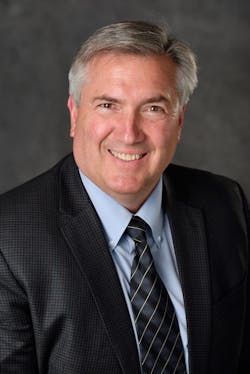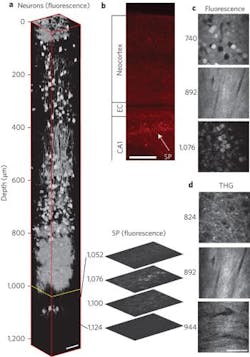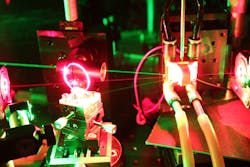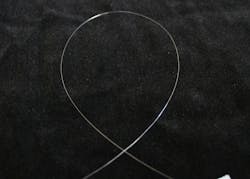Photonics West Preview: SPIE Photonics West 2017 - bring your running shoes!
Trying to cover even the most significant highlights of SPIE Photonics West has always been a challenge. But as the conference has grown over the years, Laser Focus World and BioOptics World staff have had trouble keeping up—so much so that we are considering trading our proper business-casual attire for a jogging suit and running shoes!
From January 28 to February 2, 2017, the Moscone Convention Center in San Francisco, CA, will be the site of SPIE Photonics West 2017, attracting about 20,000 curious people interested in understanding how photonics is critical to medicine; the Internet of Things (IoT); smart manufacturing and smart technologies; autonomous vehicles and vessels; electronic displays; renewable energy breakthroughs, and Industry 4.0—the catchphrase for the fourth industrial revolution, wherein computers and automation come together to make life even easier for Earth's inhabitants.
The first weekend is reserved for BiOS, the Biomedical Optics part of the symposium that is crowned by the Saturday night (January 28th) BiOS Hot Topics presentations, which never disappoints, as well as the Saturday and Sunday BiOS exposition, featuring 200 companies (see frontis).
The SPIE Photonics West exhibition from Tuesday through Thursday, January 31 to February 2, hosts 1300 exhibitors, and is ushered in by the all-conference welcome reception on Monday night. This year's theme, “Photonics—The Musical,” features the songs and artists that write and sing about science and technology, harkening back to the 2010 CLEO Conference LasersRock! extravaganza.
Application focus
Tucked into the BiOS and LASE symposia are the Translational Research, Brain, and 3D Printing application tracks, each with distinguished and dedicated symposia chairpersons that have selected the best conference-wide technical papers and tutorials that tie into these emerging disciplines. The SPIE conference planners obviously recognize that while BiOS, OPTO, and LASE technology drives new product introductions, it is the everyday "application" of those photonic products that create entirely new industries.
This applications-oriented message at SPIE Photonics West 2017 is evidenced by eight panels and special workshops in the "Industry Events" category that bring together experts to discuss and debate not only key technologies including Biophotonics (Tuesday, 7 a.m.), Solid-State Lighting (Tuesday, 8:15 a.m.), Silicon Photonics and PICs (Tuesday, 1:30 p.m.), Virtual Reality Displays (Tuesday, 3 p.m.), and 3D Printing (Wednesday, 8 a.m.), but also includes some business-oriented sessions on How Four Startups Made It (Monday, 2 p.m.), How Startups Can Avoid the Biggest Legal Mistakes (Monday, 3:30 p.m.), and also the Brexit, US Policy, EU, and China panel that attempts to detail how companies can manage through global trade shocks (Tuesday, 3:30 p.m.). After all, it takes a sound business plan as well as clever technology to fill a market need—a process you can see in action at the SPIE Startup Challenge (Wednesday, 3:30-6 pm).
In addition to key networking events, including the Women in Optics Presentation and Reception (Monday, 5 p.m.) and the ThirstyBear Speed Networking Social (Tuesday, 4:30 p.m.), don’t forget to hone your technical skills through the 72 half- and full-day courses and workshops that are aligned with the technical conference tracks, as well as 'free' professional development courses aimed at improving your technical writing, management, presentation, and even resumé writing skills. The latter may even help you prepare for the two-day (Tuesday and Wednesday) onsite Job Fair that is expected to include 30 recruiting companies.
Whether attending SPIE Photonics West 2017 to learn, present, and/or exhibit your products and technologies, seek out new products to build your system, prepare for and even find a job, or even all of the above, keep those running shoes handy. You'll need them to navigate the 5000 technical presentations across three main symposia, highlights of which we have attempted to reveal in the sections that follow. Ready, set, go!
BiOS
The Biomedical Optics Symposium (BiOS) at Photonics West 2017 will kick off Saturday, January 28, with conference sessions beginning at 8 a.m. and the exhibit hall opening at 10 a.m. (that's two hours earlier than in past years, and it means more opportunity for visitors to see commercial developments). The exhibits will continue through Sunday at 5 p.m., while the conferences will run through the week.
BiOS 2017 will feature not one (as in the past), but two 120-minute, multi-speaker plenary sessions. The ever-popular BiOS Hot Topics session will begin Saturday at 7 p.m., with presentation of the 2017 Britton Chance Biomedical Optics Award to Christopher Contag (Michigan State University and Stanford University). Contag will then describe his work using bioluminescence for in vivo optical imaging (see Fig. 1). Eight other presentations will follow: Advances in noninvasive optical biopsy by Robert Alfano (CCNY/City University of New York); cardiac optogenetics by Emilia Entcheva (George Washington University); UV surface excitation for slide-free tissue microscopy by Richard Levenson (UC Davis Medical Center); and biomedical imaging and spectroscopy with scattered light by Lev Perelman (Beth Israel Deaconess Medical Center, Harvard University). Zhongping Chen (UC Irvine) will report on frontiers in functional optical coherence tomography (OCT); Hideaki Koizumi (Hitachi) will explore diffuse optics; Alberto Diaspro (Istituto Italiano di Tecnologia) will present on nonlinear microscopy; and Enrico Gratton (UC Irvine) will discuss live-cell imaging with fluorescence spectroscopy and microscopy.The new Neurotechnologies plenary (Sunday at 3:30 p.m.) will begin with Robert Campbell (University of Alberta) summarizing work on genetically encoded indicators of neuronal activity. Francesco Pavone (Università degli Studi di Firenze) will report on optical detection of spatial-temporal correlations in whole-brain activity; Valentina Emiliani (Université Paris Descartes) will detail two-photon optogenetics with millisecond temporal precision and cellular resolution; Peter So (MIT) will reveal a strategy for monitoring synaptic activity across the full dendritic arbor; and Chris Xu (Cornell University) will talk on three-photon microscopy for deep brain imaging (see Fig. 2). Shaoqun Zeng (Wuhan National Lab for Optoelectronics) has been tapped to discuss high-throughput ex vivo brain imaging with chemical sectioning; Adam Bauer (Washington University School of Medicine in St. Louis) will bring attendees up to speed on how mapping functional connections in the mouse brain can produce insight for understanding and treating disease; Maria Angela Franceschini (Athinoula A. Martinos Center for Biomedical Imaging) will discuss clinical neuromonitoring with NIRS-DCS; Rafael Yuste (Columbia University) will reveal the impact of novel neurotechnologies on science, medicine, and society; and Edmund Talley (NIH) will conclude with an NIH funding report.
Conference presentations are again grouped into six tracks, with the one called Nano/Biophotonics (covering topics in nanoscale imaging, nanosensors, and probes, including nanoparticles) featuring a third plenary: Michael Sailor (UC San Diego) will report the use of porous silicon nanoparticles as self-reporting drug delivery vehicles.The largest track, Photonic Therapeutics and Diagnostics, includes conferences on applications from dermatology to dentistry and ophthalmology to otolaryngology, plus therapeutic approaches such as photobiomodulation, photodynamics, and molecular-guided surgery.
Clinical Technologies and Systems is a track that groups presentations related either to technologies (such as OCT or fiber optics-based systems) or to applications sharing common parameters (such as low-resource settings, or clinical diagnostics and surgical guidance).
Another large track, Biomedical Spectroscopy, Microscopy, and Imaging, incorporates various types of microscopic imaging (multiphoton and multidimensional), spectral analysis, and related topics (such as adaptive optics and data management), plus point-of-care diagnostics.
The Tissue Optics, Laser-Tissue Interaction, and Tissue Engineering track incorporates conferences on photoacoustics and ultrafast optics, and various other explorations of biological tissue using optical techniques.
The newest track, Neurophotonics, Neurosurgery, and Optogenetics (launched in 2016), includes a trio conferences, focused on clinical and translational neurophotonics, neural imaging and sensing, and optogenetics and optical manipulation.
A number of keynote presentations are sprinkled throughout the program, and from Monday to Wednesday, two-hour poster sessions will begin at 5:30 p.m. (6 p.m. on Wednesday).
Besides these six tracks, two virtual application tracks fall under the umbrella of BiOS 2017. Both will highlight related presentations included in BiOS, as well as relevant selections from the LASE and OPTO symposia.
New for 2017, and corresponding with the newest of the main conference tracks, is the Brain application track, which will direct visitors to presentations on innovations designed to increase understanding of brain function. The Brain track is chaired by 2016 Britton Chance award winner David Boas of Mass General and Harvard Medical School, and Rafael Yuste of Columbia University.
As in past years, the Translational Research track will include technologies, tools, and techniques with high potential to impact healthcare. Chairs Bruce J. Tromberg (UC Irvine) and Gabriela Apiou (Mass General) will host the Translational Research Lunchtime Forum on Sunday to highlight select work.
Besides the 10 BiOS Best Paper awards sponsored by various organizations and emphasizing different specifics, BiOS will include a "Lunch with the Experts" student networking event on Sunday and SPIE’s inaugural Biophotonics Executive Forum (Tuesday, 7–12:30 p.m). In addition, biomedical optics will be the focus of the 2017 SPIE Fellows Luncheon on Monday, which will feature Erik Herzog (Washington University, St. Louis) in a talk titled Imaging Circadian Gene Expression in Real Time. Also on Monday, Laser Focus World’s Lasers and Photonics Marketplace Seminar, held at the San Francisco Marriott Marquis, will feature a keynote by Dartmouth College Professor of Surgery Brian Pogue, and a panel discussion featuring bioinstrumentation makers on how photonics suppliers can help drive research and clinical advances.
LASE
Organized into four tracks (Laser Sources, Nonlinear Optics and Beam Guiding, Micro/Nano Applications, and Macro Applications), the LASE Symposium includes 781 papers in 16 different conference sessions from the total 797 that were submitted.
RIKEN unit leader and LASE Symposium chair Koji Sugioka encourages conference-goers to attend the LASE Plenary Session (Wednesday, February 1, 10:20–12:30 p.m.). Plenary presentations include "Gravitational Wave Astronomy: News from the Dark Side of the Universe" (paper 10096-501), where researchers from the Max Planck Institute for Gravitational Physics and Leibniz University Hannover describe how we will now be able to listen to the universe using gravitational waves with detectors on the ground and soon in deep space. The "Printing Hybrid Electronics by Laser Direct-Write" (paper 10095-502) from the Naval Research Lab describes how laser direct-write (LDW) techniques are expanding as additive manufacturing (AM) becomes more established. With LDW, laser-induced forward transfer (LIFT), and other microfabrication processes, microfabrication of hybrid circuits for next-generation, 3D-printed electronics are possible. And finally, Plenary paper 10097-503 from Gigaphoton describes "Development of a 250W EUV Light Source for HVM Lithography" with 118 W average clean power and 100 kHz operation.
Michael Jetter of Universität Stuttgart and conference chair for Vertical-external cavity surface-emitting lasers or VECSELs VII in the Laser Sources track singled out a paper that he says is the realization of a proposed concept that has the potential to completely revolutionize optically pumped semiconductor disk lasers: the MECSEL (see Fig. 3).Paper 10087‐18 from Hermann Kahle and colleagues at Universität Stuttgart entitled "Further development on VECSELs: The optically pumped semiconductor membrane external‐cavity surface‐emitting laser (MECSEL)—A concept based on a diamond‐sandwiched active region" explains that even though VECSELs have wide application in biophotonics, projection, spectroscopy, and lithography with near-diffraction-limited beam quality, CW operation, a flexible external resonator, and power scalability, these systems suffer from heat buildup in the active region caused by the excess energy of the pump photons together with the low thermal conductivity of the substrate and the included distributed Bragg reflector (DBR).
Alternatively, the researchers describe a MECSEL in which the active region (no DBR, no substrate) is sandwiched between two diamond heatspreaders, allowing growth of semiconductor structures that are otherwise impossible to grow because of limitations imposed by the need to lattice‐match the DBR to the substrate or the active region to the DBR. These MECSELs expand the choice of possible materials and compositions and correspondingly, the accessible wavelength range for semiconductor-based lasers with high‐quality beam parameters.
Other LASE top paper recommendations from the conference chairs include "Micro and nano-biomimetic structures for cell migration study fabricated by hybrid subtractive and additive 3D femtosecond laser processing" (paper 10092-6), "Development of the scanner-based direct laser interference patterning technology: New surface structuring opportunities" (Paper 10092-38), "Mid-infrared supercontinuum generation up to 15.1 µm in a chalcogenide step-index optical fiber" (paper 10088-10), "Instantaneous spectral span of 2.85–8.40 µm achieved in a Cr:ZnS laser pumped subharmonic OPO" (paper 10088-8), and "High average power, scalable, all diode-pumped solid state petawatt laser system: Enabling future applications with bright secondary sources" (paper 10084-16).
OPTO
The four presentations at the OPTO Plenary session on Monday all cover relatively new and fast-growing topics in photonics, including a talk by Shanhui Fan of Stanford University on the use of thermal metamaterial surfaces for controlling light and heat in devices that are far from thermodynamic equilibrium (which includes the case of most solar absorbers); a talk by Dieter Bimberg of the Technische Universität Berlin on quantum-dot (QD)-based photonics, including optical amplifiers and single- and entangled-photon emitters; an overview of LiFi, which is the light-based equivalent of WiFi, given by Harald Haas from The University of Edinburgh and pureLiFi; and a presentation by Michael Sailor of the University of California, San Diego on porous silicon nanoparticles as biocompatible drug-delivery vehicles that can report on their status.
Conference program tracks for OPTO include Optoelectronic Materials and Devices, Photonic Integration, Nanotechnologies in Photonics, MOEMS-MEMS in Photonics, Advanced Quantum and Optoelectronic Applications, Semiconductor Lasers and LEDs, Displays and Holography, and Optical Communications: Devices to Systems.
The Optical Components and Materials track includes a presentation (paper 1011-3) from General Opto Solutions and the U.S. Army Research Laboratory on a diode-pumped crystalline-core/crystalline-clad fiber laser pumped at a high numerical aperture (NA) of 0.55 and emitting at a low 0.076 NA (see Fig. 4), and a subsequent presentation (paper 10100-4) by researchers from the U.S. Naval Research Laboratory, Sotera Defense Solutions, and the University Research Foundation on a single-crystal YAG fiber laser with potential for high-power applications.Photonic Integration includes both non-silicon and silicon integrated devices, the former exemplified by a talk (paper 10106-2) by European scientists on glass and glass-ceramic photonic systems with both bulk and planar waveguides and elements consisting of glasses and glass-ceramics activated by rare-earth ions; and the latter by a presentation given by Imec and other researchers on new materials for modulators and switches in silicon photonics, including components based on graphene and other 2D materials, as well as on ferroelectric materials.
MOEMS-MEMS in Photonics contains a presentation (paper 10116-2) on expanding the use of electrostatic forces in MEMS transducers, replacing piezoelectricity or electromagnetism for some applications and gaining good scaling behavior. Another talk (paper 10116-7) by a group at Ecole Polytechnique Fédérale de Lausanne (Switzerland) and SUSS MicroOptics covers the scaling behavior of optical laws in wavelength-scale micro-optical systems, including the fact that performance of aberrated microlenses could be limited by diffraction rather than by aberrations, and the birth of unconventional phenomena such as a strong focal shift by high-NA wavelength-scale microlenses.
In Displays and Holography, Yajie Dong of CREOL, The College of Optics and Photonics, will describe (paper 10126-4) the use of photoluminescent (PL) and electroluminescent (EL) quantum dots (QDs) for lighting, displays, and other uses; a red QD light-emitting device (QLED) with record luminance of 165,000 Cd/m2 will be presented.
The Free-Space Laser Communication and Atmospheric Propagation portion of Optical Communications: Devices to Systems includes a description (paper 10096-1) by researchers at the U.S. Naval Research Laboratory of a very practical way of characterizing laser transmission beam wander and scintillation over a close-to-ground range of 4.2 km: use high-speed imaging to capture the beam cross-section and motion through different types of atmospheric turbulence and for different beam-divergence angles. A group at Applied Technology Associates presents (paper 10096-14) a design for a stabilized, compact gimbal for space-based free space optical communications that has 100 μrad pointing accuracy and 10 degrees per second slew capability.
One hot topic: 3D printing and additive manufacturing
The 3D Printing Symposium is a multidisciplinary track that highlights papers from BiOS, LASE, and OPTO, and showcases innovative ways to apply additive manufacturing (AM) technology. "Metal AM is smoking hot, smoking hot," said well-known 3D printing and AM market researcher Terry Wohlers of Wohlers Associates, when speaking at the recent Inside 3D Printing conference in San Diego. To understand the speed of growth for just the metal AM manufacturing sector, in 2011 only 31 companies sold industrial-grade AM systems compared to 62 companies today.
Smoking hot is the feeling one gets reviewing the talks included in the symposium, which is chaired by Henry Helvajian, a senior scientist at The Aerospace Corporation's Physical Sciences Laboratory. Topics go far beyond metal AM and include selective laser melting, laser sintering, and laser photopolymerization, along with talks on novel materials, protean materials, and laser interactions. Other topics are software that increases speed and efficiencies, test and measurement of manufacturing processes, and photonics-enabled conformal electronics.
The papers range from biophotonics-related topics such as 3D printing based on cellular-level OCT images (paper 10053-128) from University of Miami scientists, a Purdue University presentation on 3D printing of optical phantoms and deep tissue imaging for dental surgery (paper 10056-3), to industrial laser applications such as TU Dresden's report on direct laser interference patterning of metallic sleeves for roll-to-roll hot embossing (paper 10092-27) as well as a presentation on metal micro-additive manufacturing based on parallel femtosecond laser machining and electrodeposition (Paper 10094-20) from the Chinese University of Hong Kong.
At the LASE Plenary on Wednesday, Helvajian will present the best paper award for 3D printing, fabrication, and manufacturing. Also, during the Plenary, Alberto Piqué, Branch Head at the U.S. Naval Research Lab, will give a talk on printing hybrid electronics by laser direct-write techniques. And finally, on Wednesday morning from 8 to 10 a.m., SPIE will host a panel titled: 3D Printing: New Challenges and Opportunities, with panelists from Trumpf and GE Aviation to discuss how 3D printing can reach its economic potential.

Gail Overton | Senior Editor (2004-2020)
Gail has more than 30 years of engineering, marketing, product management, and editorial experience in the photonics and optical communications industry. Before joining the staff at Laser Focus World in 2004, she held many product management and product marketing roles in the fiber-optics industry, most notably at Hughes (El Segundo, CA), GTE Labs (Waltham, MA), Corning (Corning, NY), Photon Kinetics (Beaverton, OR), and Newport Corporation (Irvine, CA). During her marketing career, Gail published articles in WDM Solutions and Sensors magazine and traveled internationally to conduct product and sales training. Gail received her BS degree in physics, with an emphasis in optics, from San Diego State University in San Diego, CA in May 1986.

John Wallace | Senior Technical Editor (1998-2022)
John Wallace was with Laser Focus World for nearly 25 years, retiring in late June 2022. He obtained a bachelor's degree in mechanical engineering and physics at Rutgers University and a master's in optical engineering at the University of Rochester. Before becoming an editor, John worked as an engineer at RCA, Exxon, Eastman Kodak, and GCA Corporation.

Barbara Gefvert | Editor-in-Chief, BioOptics World (2008-2020)
Barbara G. Gefvert has been a science and technology editor and writer since 1987, and served as editor in chief on multiple publications, including Sensors magazine for nearly a decade.

Conard Holton
Conard Holton has 25 years of science and technology editing and writing experience. He was formerly a staff member and consultant for government agencies such as the New York State Energy Research and Development Authority and the International Atomic Energy Agency, and engineering companies such as Bechtel. He joined Laser Focus World in 1997 as senior editor, becoming editor in chief of WDM Solutions, which he founded in 1999. In 2003 he joined Vision Systems Design as editor in chief, while continuing as contributing editor at Laser Focus World. Conard became editor in chief of Laser Focus World in August 2011, a role in which he served through August 2018. He then served as Editor at Large for Laser Focus World and Co-Chair of the Lasers & Photonics Marketplace Seminar from August 2018 through January 2022. He received his B.A. from the University of Pennsylvania, with additional studies at the Colorado School of Mines and Medill School of Journalism at Northwestern University.




